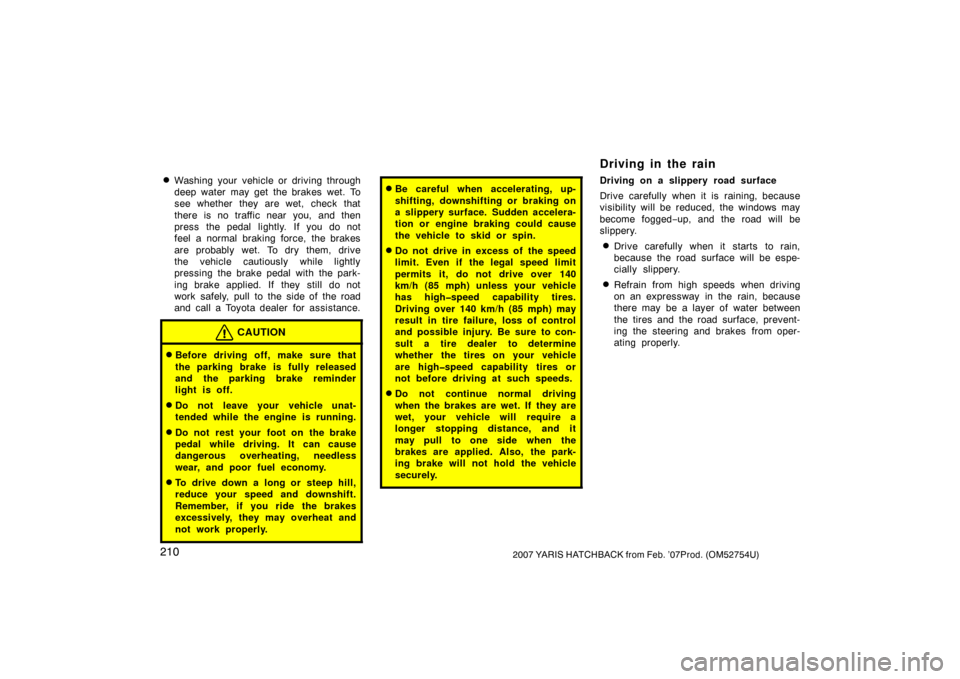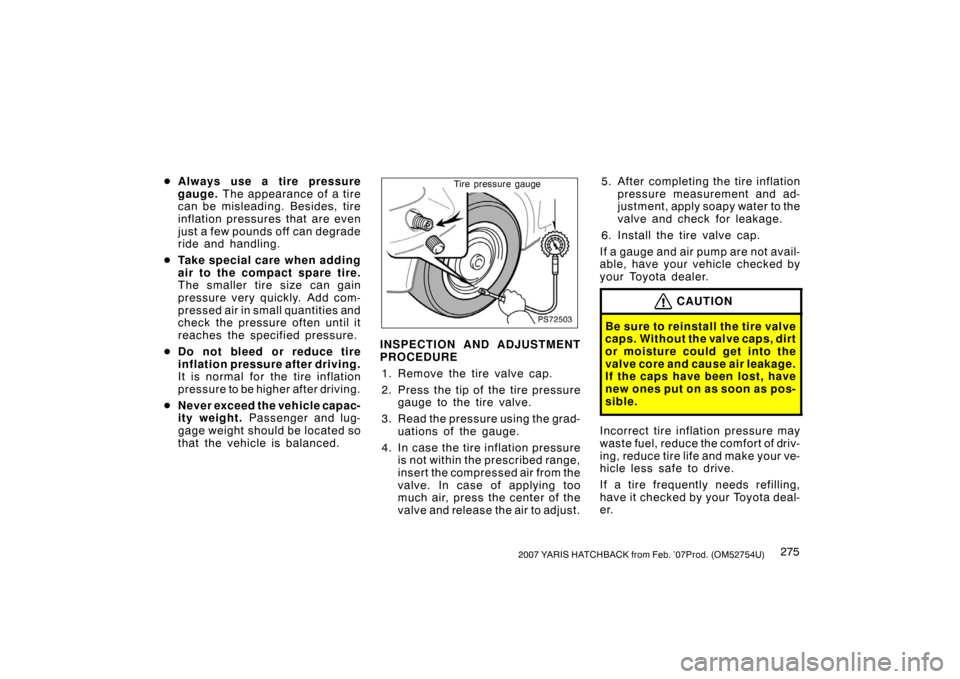Page 38 of 313

302007 YARIS HATCHBACK from Feb. ’07Prod. (OM52754U)
PS12535
1. To open the fuel filler door, pull thelever up.
When refueling, turn off the engine.
CAUTION
�Do not smoke, cause sparks or al-
low open flames when refueling.
The fumes are flammable.
�When opening the cap, do not re-
move the cap quickly. In hot weath-
er, fuel under pressure could cause
injury by spraying out of the filler
neck if the cap is suddenly re-
moved.
PS12536
2. To remove the fuel tank cap, turnthe cap slowly counterclockwise,
then pause slightly before removing
it. After removing the cap, hang the
tether as shown in the illustration.
It is not unusual to hear a slight swoosh
when the cap is opened.
When installing the cap, turn it clock-
wise until one click is heard, in order
to fully close it. The cap returns slight-
ly when your hand is released from the
cap after closure, however this does
not cause any problems.
If the cap is not tightened securely, the
malfunction indicator lamp comes on.
Make sure the cap is tightened securely. The indicator lamp goes off after driving
several times. If the indicator lamp does
not go off, contact your Toyota dealer as
soon as possible.
CAUTION
�Make sure the cap is installed se-
curely to prevent fuel sp
illage in
the event of an accident.
�Use only a genuine Toyota fuel tank
cap for replacement. It is designed
to regulate fuel tank pressure.
Page 218 of 313

2102007 YARIS HATCHBACK from Feb. ’07Prod. (OM52754U)
�Washing your vehicle or driving through
deep water may get the brakes wet. To
see whether they are wet, check that
there is no traffic near you, and then
press the pedal lightly. If you do not
feel a normal braking force, the brakes
are probably wet. To dry them, drive
the vehicle cautiously while lightly
pressing the brake pedal with the park-
ing brake applied. If they still do not
work safely, pull to the side of the road
and call a Toyota dealer for assistance.
CAUTION
�Before driving off, make sure that
the parking brake is fully released
and the parking brake reminder
light is off.
�Do not leave your vehicle unat-
tended while the engine is running.
�Do not rest your foot on the brake
pedal while driving. It can cause
dangerous overheating, needless
wear, and poor fuel economy.
�To drive down a long or steep hill,
reduce your speed and downshift.
Remember, if you ride the brakes
excessively, they may overheat and
not work properly.
�Be careful when accelerating, up-
shifting, downshifting or braking on
a slippery surface. Sudden accelera-
tion or engine braking could cause
the vehicle to skid or spin.
�Do not drive in excess of the speed
limit. Even if the legal speed limit
permits it, do not drive over 140
km/h (85 mph) unless your vehicle
has high�speed capability tires.
Driving over 140 km/h (85 mph) may
result in tire failure, loss of control
and possible injury. Be sure to con-
sult a tire dealer to determine
whether the tires on your vehicle
are high�speed capability tires or
not before driving at such speeds.
�Do not continue normal driving
when the brakes are wet. If they are
wet, your vehicle will require a
longer stopping distance, and it
may pull to one side when the
brakes are applied. Also, the park-
ing brake will not hold the vehicle
securely.
Driving in the rain
Driving on a slippery road surface
Drive carefully when it is raining, because
visibility will be reduced, the windows may
become fogged−up, and the road will be
slippery.
�Drive carefully when it starts to rain,
because the road surface will be espe-
cially slippery.
�Refrain from high speeds when driving
on an expressway in the rain, because
there may be a layer of water between
the tires and the road surface, prevent-
ing the steering and brakes from oper-
ating properly.
Page 283 of 313

2752007 YARIS HATCHBACK from Feb. ’07Prod. (OM52754U)
�Always use a tire pressure
gauge. The appearance of a tire
can be misleading. Besides, tire
inflation pressures that are even
just a few pounds off can degrade
ride and handling.
� Take special care when adding
air to the compact spare tire.
The smaller tire size can gain
pressure very qu ickly. Add com-
pressed air in small quantities and
check the pressure often until it
reaches the specified pressure.
� Do not bleed or reduce tire
inflation pressure after driving.
It is normal for the tire inflation
pressure to be higher after driving.
� Never exceed the vehicle capac-
ity weight. Passenger and lug-
gage weight should be located so
that the vehicle is balanced.
PS72503
Tire pressure gauge
INSPECTION AND ADJUSTMENT
PROCEDURE
1. Remove the tire valve cap.
2. Press the tip of the tire pressure gauge to the tire valve.
3. Read the pressure using the grad- uations of the gauge.
4. In case the tire inflation pressure
is not within the prescribed range,
insert the compressed air from the
valve. In case of applying too
much air, press the center of the
valve and release the air to adjust. 5. After completing the tire inflation
pressure measurement and ad-
justment, apply soapy water to the
valve and check for leakage.
6. Install the tire valve cap.
If a gauge and air pump are not avail-
able, have your vehicle checked by
your Toyota dealer.
CAUTION
Be sure to reinstall the tire valve
caps. Without the valve caps, dirt
or moisture could get into the
valve core and cause air leakage.
If the caps have been lost, have
new ones put on as soon as pos-
sible.
Incorrect tire infl ation pressure may
waste fuel, reduce the comfort of driv-
ing, reduce tire life and make your ve-
hicle less safe to drive.
If a tire frequently needs refilling,
have it checked by your Toyota deal-
er.